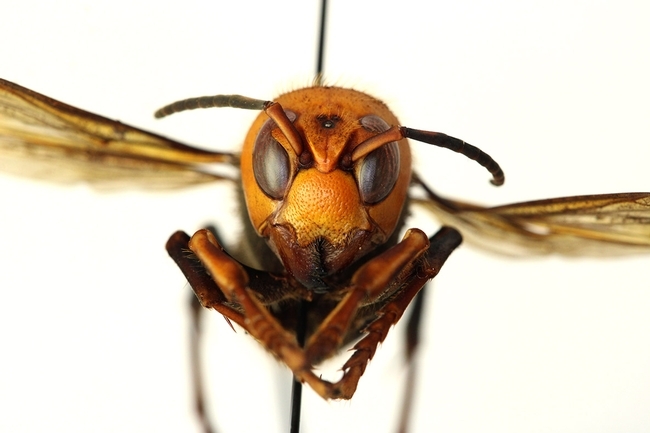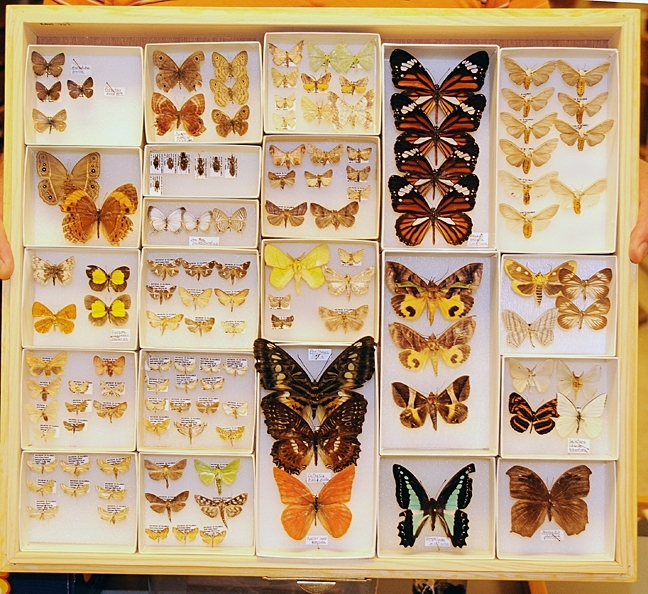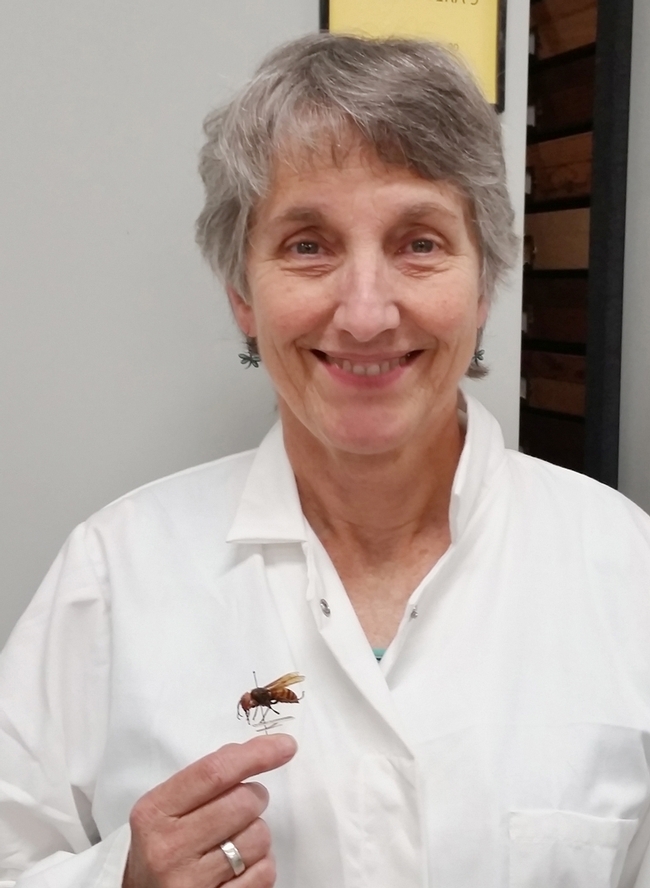- Author: Kathy Keatley Garvey
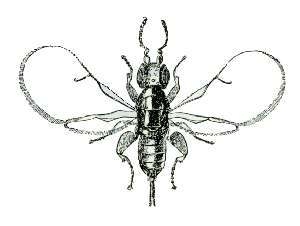
These little insects pollinate figs, but some figs are self-pollinated.
"There's no real way to tell from the outside, but if the fig contains seeds it will have been pollinated [by a fig wasp],” UC Extension specialist Louise Shanahan, based at the UC Davis Department of Plant Sciences, told writer Ali Francis of the magazine Bon Appétit in a Sept. 7, 2022 feature article, "What Do You Mean There Are Dead Wasps in My Figs?"
Now for the entomological side.
Fig wasps will be among the wasps discussed when the Bohart Museum of Entomology at UC Davis hosts an open house, "Weird and Wonderful Wasps" from 1 to 4 p.m., Sunday, Sept. 25 in Room 1124 of the Academic Surge Building, 455 Crocker Lane, UC Davis campus. It's free and family friendly.
"Fig wasps are among the weirdest insects I can think of both in their obligatory relationship with plants and the strange looking males," said Lynn Kimsey, director of the Bohart Museum and a UC Davis distinguished professor of entomology. "Females are winged and wasp-like; males on the other hand spend their entire lives in the fig fruits and look really strange and are wingless and often look like they only have four legs."
Fig wasps belong to the superfamily Chalcidoidea and spend their larval stage inside figs. "Most are pollinators but others simply feed off the plant," according to Wikipedia. "The non-pollinators belong to several groups within the superfamily Chalcidoidea, while the pollinators are in the family Agaonidae. While pollinating fig wasps are gall-makers, the remaining types either make their own galls or usurp the galls of other fig wasps; reports of them being parasitoids are considered dubious."
Sunday's open house is the first open house of the academic year. The focus will be on a variety of wasps, including Asian giant hornets, aka "murder hornets," pteromalids, oak galls, and fig wasps, among others.
"At the wasp event, we will also have some photos from Dr. Ismail Seker, who earlier displayed his coffee table book on silk moths," said Tabatha Yang, the Bohart Museum's education and outreach coordinator. Seker, a Turkish-trained medical doctor, "has a book coming out on chestnuts next, but he is working on olives and figs as well," Yang added. (See Bug Squad blog on Dr. Seker's silk moth presentation at the Bohart Museum). Seker's son, Erkin Seker, is a UC Davis professor in the Department of Electrical and Computer Engineering.
Visitors are also invited to hold and take images of the insects from the live "petting zoo," which will include Madagascar hissing cockroaches and stick insects, also known as "walking sticks."
Visitors will learn about the smallest fairy wasps to the "murder hornets"; what role wasps play in plant galls and figs; and how to distinguish a parasitoid from a parasite. Kimsey will discuss the Asian giant hornet, Vespa mandarinia, dubbed by the news media as “the murder hornet." The Entomological Society of America recently established as its official common name, “northern giant hornet.”
The Bohart Museum is the home of a global collection of eight million insect specimens. It also houses a live “petting zoo,” comprised of Madagascar hissing cockroaches, stick insects and tarantulas; and a gift shop with insect-themed items. More information is available on the website at https://bohart.ucdavis.edu or by contacting bmuseum@ucdavis.edu.
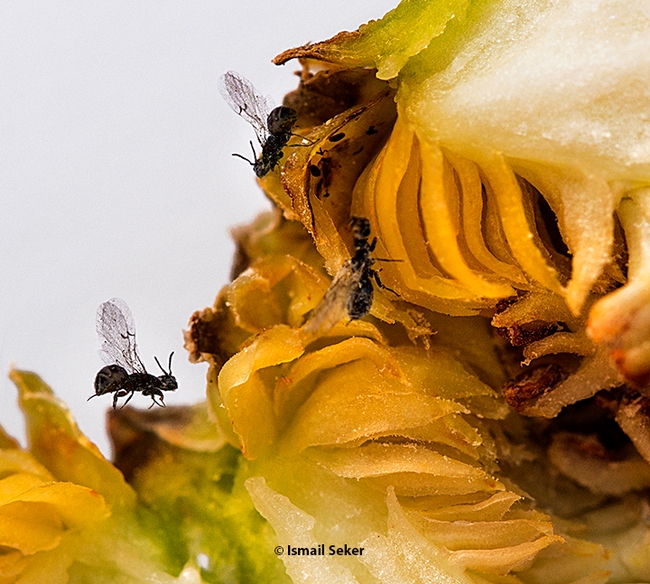
- Author: Kathy Keatley Garvey
Do you have a question about wasps or want to learn more about them?
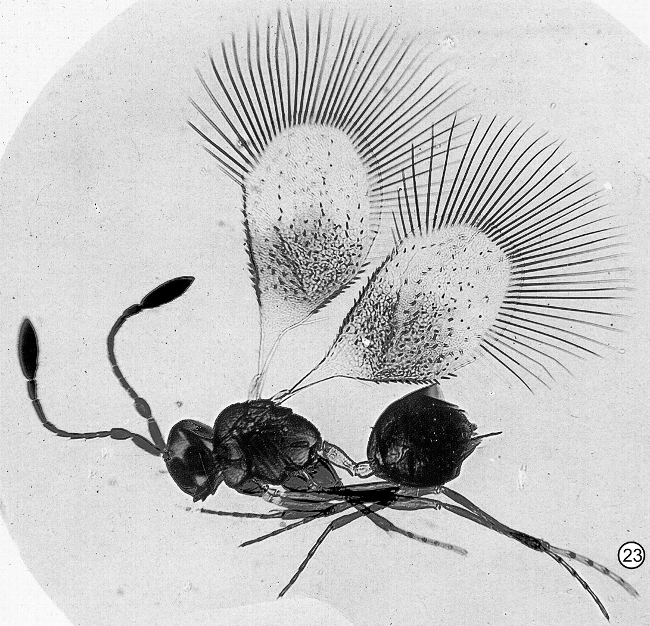
It's the first open house of the academic year and will focus on Asian giant hornets, aka "murder hornets," pteromalids, oak galls, and fig wasps, among others.
The family arts-and-crafts activity will be to create "gall ghosts."
Visitors are also invited to hold and take images of the insects from the live "petting zoo," which will include Madagascar hissing cockroaches and stick insects, also known as "walking sticks."
Visitors will learn about the smallest fairy wasps to the "murder hornets"; what role wasps play in plant galls and figs; and how to distinguish a parasitoid from a parasite. Lynn Kimsey, director of the Bohart Museum and a UC Davis distinguished professor of entomology, will discuss the Asian giant hornet, Vespa mandarinia, dubbed by the news media as “the murder hornet." The Entomological Society of America recently established as its official common name, “northern giant hornet.”
A single colony of the Asian giant hornet was found and destroyed Sept. 18, 2019 in Nanaimo, Vancouver Island, Canada, and a single dead hornet was found Dec. 8, 2019 in nearby Blaine, Wash. Since then, it also has been sighted-- and destroyed--in both Canada and Washington state.
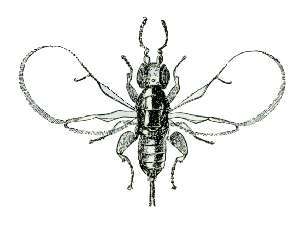
Kimsey and two other wasp experts published “The Diversity of Hornets in the Genus Vespa (Hymenoptera: Vespidae; Vespinae); Their Importance and Interceptions in the United States,” in the journal Insect Systematics and Diversity in May of 2020. (See https://bit.ly/3BVZ34Y)
Lead author Allan Smith-Pardo, U.S. Department of Agriculture Animal and Plant Health Inspection Service (APHIS), and co-authors James Carpenter of the American Museum of Natural History's Division of Invertebrate Zoology, and Kimsey covered 22 species of hornets, including V. mandarinia.
Fairy wasps, which belong to the family of chalcidoid wasps, are tiny insects that include the world's smallest known insect, with a body length of 0.139mm, and the smallest known flying insect, only 0.15mm. All known fairy wasps are parasitoids of the eggs of other insects.
Other special events planned by the Bohart Museum this year include:
Saturday, Oct. 15, 1 to 4 p.m.
Insects, Art & Culture
Visitors will learn about insects through the lenses of art and culture. This event is part of Spirit Week (Oct. 10-16) for Aggie students, parents and alumni, but all are welcome.
Saturday, Oct. 15, 11 to 11:50 a.m.
Special Talk: Plants, Insects and Art: Mary Foley Benson's Scientific Illustrations
Location: Teaching and Learning Complex (TLC) Building, 482 Hutchison Drive, UC Davis campus
This event is part of Spirit Week for Aggie students, parents and alumni, but all are welcome. Srdan Tunic, a candidate for a master's degree in art history and a Bohart associate, will be highlighting the scientific illustrations of Mary Foley Benson (1905-1992), formerly of the U. S. Department of Agriculture's Bureau of Entomology and the Smithsonian Institution and who later worked for UC Davis entomologists. Much of her work appears on campus. (See research story on the artist by Malcolm Furniss)
Sunday, Nov. 6, 1 to 4 p.m.
Dragonflies Rule!
Dragonflies are described as "the ultimate predator both in the water and the air." Visitors will meet scientists and natural historians who will share information on the world of dragonflies.
The Bohart Museum is the home of a global collection of eight million insect specimens. It also houses a live “petting zoo,” comprised of Madagascar hissing cockroaches, stick insects and tarantulas; and a gift shop with insect-themed items. More information is available on the website at https://bohart.ucdavis.edu or by contacting bmuseum@ucdavis.edu.
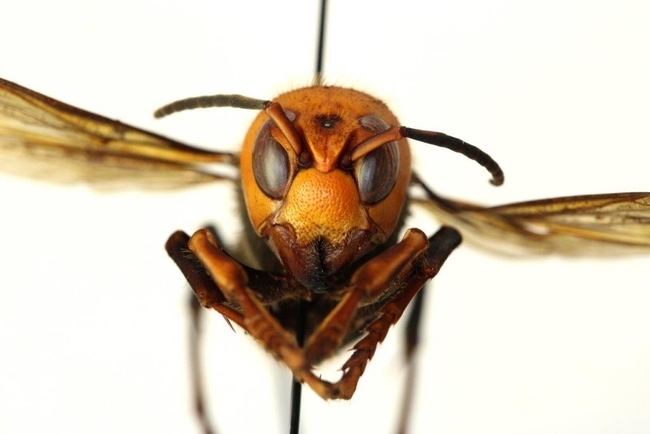
- Author: Kathy Keatley Garvey
Oh, the questions that Lynn Kimsey, director of the Bohart Museum of Entomology, fielded at the Bohart's first-ever virtual symposium, held Friday morning, May 22.
For nearly an hour (11 to 11:45), Kimsey answered questions about the Asian giant hornet (aka "the murder hornet," so labeled by the news media); earwigs, native bees, midges, cockroaches, butterflies, yellow jackets and mosquitoes, and others.
Kimsey, a UC Davis professor of entomology and a two-time president of the International Society of Hymenopterists, related how a single colony of Asian giant hornets (Vespa mandarinia) was detected and destroyed on Vancouver Island, British Columbia, and a single hornet was found dead in Blaine, Wash. They are the first and only Asian giant hornets detected in North America. There is no invasion.
Unfortunately, she said, other insects are being mistaken for the giant hornets, including the Jerusalem cricket, known as "the potato bug." Even "dog vomit" is being mistaken for giant hornets, she said, pointing out that a Washington state colleague shared with her a photo of dog vomit. Someone figured a dog had swallowed an Asian giant hornet and "that's why it threw up," Kimsey told her virtual audience.
In Asia, "people live with them and they don't find them particularly troubling" any more than we do our yellow jackets, she said.
"In Asia, people eat these things, which shows you how terrified they are of them," quipped Kimsey, mentioning that her former graduate student, Matan Shelomi, now an assistant professor of entomology at the National Taiwan University in Taipei, Taiwan, has dined on the cooked larval and pupae dishes at Taiwanese restaurants.
The UC Davis professor said that the Japanese honey bees are larger than our European bees and form a ball to "cook" an Asian hornet. "They (honey bees) pick up the smell (of a hornet targeting their colony), cover it, and shiver their flight muscles to generate heat. They can raise it (the temperature) to well over 100 degrees Fahrenheit, which cooks the hornet."
Kimsey showed hornet and bee specimens from the Bohart collection. The hornet is about an inch and a half long, and "rarely gets up to 2 inches," despite what the media is saying, she said. "An inch and a half is still a big animal."
Unlike the honey bee workers, a hornet can sting multiple times. "Because it's such a large animal, it has more venom (than a honey bee)," she said, quipping "You could think about how nice they taste."
Kimsey said she's been stung by hornets and honey bees, and the sting of a honey bee hurts much more.
When she finished her presentation on "murder hornets," UC Davis spider specialist Jason Bond jokingly asked: “is there such a thing as a murder spider?” (A future Bohart Museum virtual house is scheduled to cover spiders. Bond, a noted spider authority and the Evert and Marion Schlinger Endowed Chair in Insect Systematics, UC Davis Department of Entomology and Nematology, recently discovered a new genus of spiders in Monterey County and is seeking public input on the species name. Suggestions are to be emailed to him at jbond@ucdavis.edu by 5 p.m, June 1. See more here.)
Someone also asked Kimsey: "Are there murder mosquitoes?"
Other highlights of the virtual open house:
- On the website, you can access a drawing of an Asian giant hornet and download and color it. It is the work of UC Davis undergraduate student Meghan Crebbins-Oats. In addition, there's a drawing of a western yellowjacket to download and color; it is by artist Melinda Zavala.
- Also on the website, you can access a Swedish cinnamon roll recipe, posted there in connection with the Bohart's celebration of the birthday anniversary (May 23) of Swedish-born Linnaeus, "the father of modern taxonomy." UC Davis doctoral student Charlotte Herbert Alberts, of Swedish heritage, selected the recipe.
The Bohart Museum, located in Room 1124 of the Academic Surge Building, UC Davis campus, is the home of some 8 million insect specimens. It also includes a live "petting zoo" (including Madagascar hissing cockroaches, walking sticks and tarantulas) and a gift shop. In keeping with the mandated coronavirus pandemic precautions, the Bohart is closed until further notice.
Access the Facebook Live recorded video here.
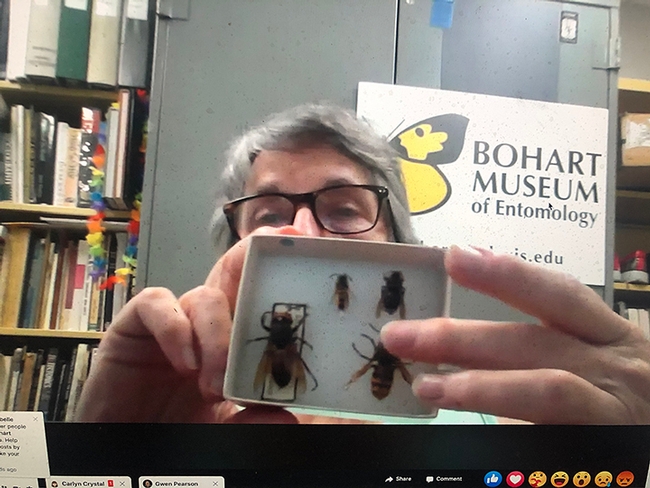
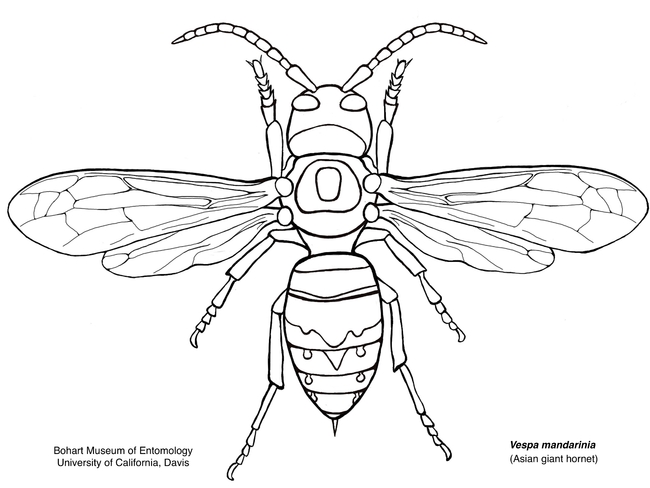
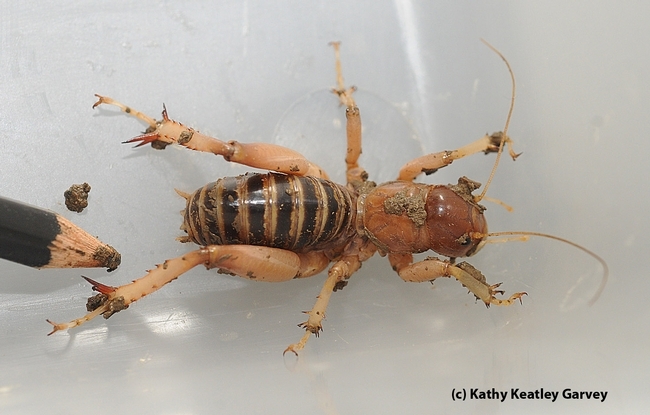
- Author: Kathy Keatley Garvey
If Lynn Kimsey, who directs the Bohart Museum of Entomology, UC Davis, had her say, the Asian giant hornets would NOT be nicknamed “the murder hornets.”
Kimsey, professor of entomology with the UC Davis Department of Entomology and Nematology and a past president (twice) of the International Society of Hymenopterists, will headline the Bohart Museum's virtual open house (Facebook Live) from 11 a.m. to 11:45 on Friday, May 22. It's the first-ever virtual open house; you can access it and ask questions on the Bohart Facebook page.
The theme is bees and wasps, so Professor Kimsey expects a number of questions about those obscure Asian giant hornets detected last fall in Canada and Washington state, the first confirmed sightings in North America. (One colony was detected and destroyed on Vancouver Island in September, and a single dead adult was found in Blaine, Wash. in December.
However, a news frenzy ("murder hornets are invading North America!") and considerable panic ensued.
So we asked Kimsey (she's granted six news media interviews on murder hornets to date), “What would you call them?”
“I'd just call them giant hornets,” she said matter-of-factly.
And then, in typical Kimsey humor, she deadpanned: “Or big, angry, orange-headed hornets!”
Meanwhile, the Bohart folks' unannounced test drive on Facebook Live earlier this week drew some unexpected participants and a few questions, such as:
- Do mantids often prey on hummingbirds?
- Why are some beetles metallic in color?
- What California beetle is attracted to fresh paint?
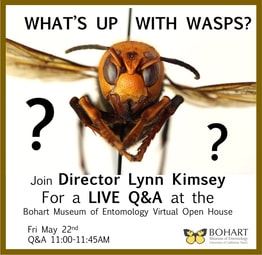
"On the website we will have a coloring sheet of the Asian giant hornet drawn by our scientific illustration intern Meghan Crebbins-Oats, an undergrad at UC Davis.”
The Bohart also will celebrate Linnaeus' birthday anniversary. Linnaeus (1707-1778), a Swedish taxonomist and physician known as "the father of modern taxonomy," was born May 23.
UC Davis doctoral student and Bohart associate Charlotte Herbert Alberts, who maintains strong ties to Sweden and taxonomy, thought that a traditional Swedish Fika with Kanelbullar to discuss taxonomy and Linnaeus would be "perfect."
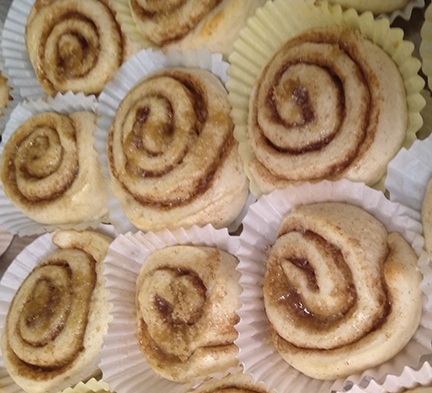
"Hopefully people will be inspired to make some cinnamon buns, color, and think about names for Jason's new spider." (UC Davis professor Jason Bond discovered a new genus in Monterey County and is seeking a species name. (See Bug Squad blog about the spider and where to submit names.)
"The kanelbullars are not overly sweet and the dough is infused with cardamon," said Yang, who baked them for her family this week. They were a big hit.
Meanwhile, Kimsey is ready for lots of questions Friday morning on Facebook Live.
Don't be too surprised if she's asked about that "big, angry, orange-headed hornet."
